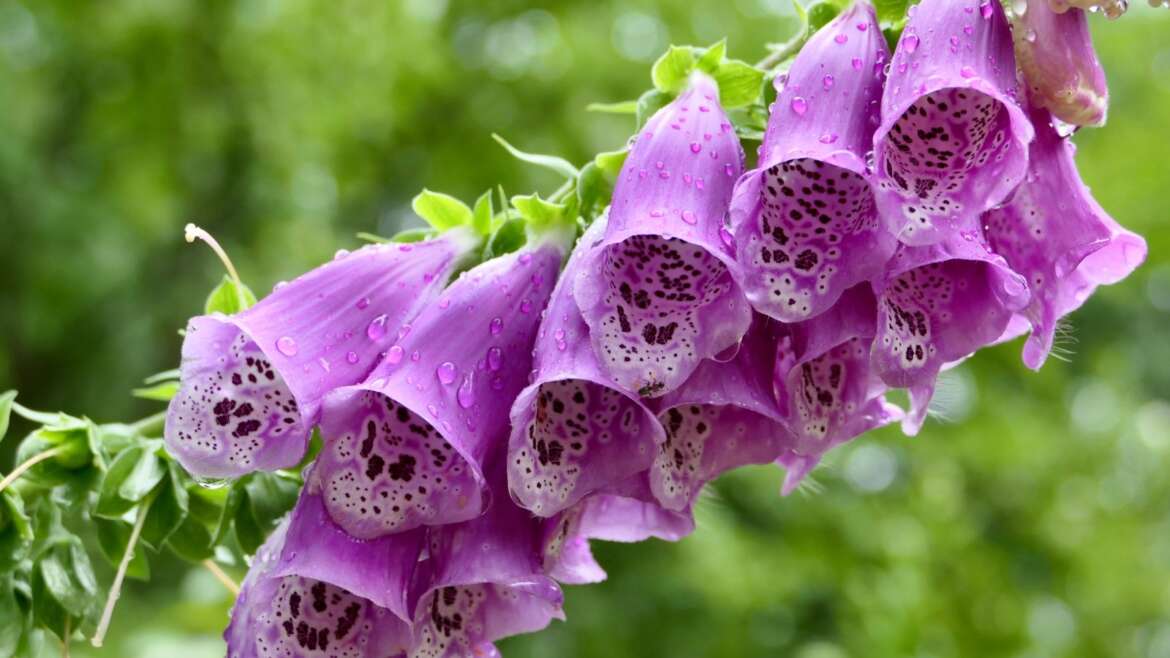Foxgloves are both delightful and ominous plants. They have a reputation for their lovely, bell-shaped flowers. They make an excellent addition to the cottage garden. They are also highly poisonous to humans and pets, so treating these plants with a healthy respect is important. If you have a curious child or pet who you think might nibble on the occasional plant, steer clear of this one.
Aside from that one rather dangerous trait, foxgloves make wonderful garden plants. Their tall, graceful stems make them an obvious choice for planting in the middle or background of your flower garden. It is upon these stems that a profusion of flowers will bloom.
The flower racemes of a foxglove plant can hold anywhere from 20-80 individual flowers. These darling little blooms have always reminded me of a fairy’s hat. They are long and tubular, with one end flared open. The opening points downward in most cases.
While the plants are toxic to most creatures, pollinators have no issues with them. The most common pollinators are long-tongued bumblebees and hummingbirds. These can reach the base of the floral tube, where the nectar resides.
When our ornamental plants don’t perform as we expected, there are things we can do to help nature along. Figuring out why your plant isn’t flowering is the first step. Then, understanding what your plant needs is much easier. So, what happens if your foxgloves refuse to bloom? What causes it, and how can we fix it? Let’s take a look.
The Short Answer
If your foxgloves aren’t blooming in their first year, don’t fret. These biennial plants typically don’t. Of course, there are exceptions and other reasons your plant could be lacking blooms. Making sure your plants have the proper environment and care should get those flowers blooming in no time.
The Long Answer
Identifying the issue is key to helping plants bloom.
There is more than one reason why any particular plant is having blooming issues. There is not a one-size-fits-all solution to making this or any plant bloom. However, if we understand what the hold-up is, we can usually help the plant along.
The Most Likely Culprit
 Foxgloves bloom in their second year.
Foxgloves bloom in their second year.
The main reason your foxglove plants may not be blooming is quite simple. This applies specifically to new plants that are in their first season.
Foxgloves are biennial plants. This means that they bloom in their second year rather than their first, like annuals and many perennials. Your plant may not be mature yet and will require an additional year to grow.
Patience is the only remedy for this problem. There are a few early-blooming varieties, and if you are just embarking on your foxglove journey, this is a great place to start. However, you’re probably here because you already have these plants. Likely they are not blooming because they are not early-blooming varieties. Give your plants another year, and make sure to keep up with proper care for strong, healthy plants in the next season.
Sun Exposure
 Afternoon sun in hot climates can burn foxglove foliage.
Afternoon sun in hot climates can burn foxglove foliage.
Foxgloves do not need full sun to bloom, but they do need some sunlight. The ideal light situation for these plants is partial sun or filtered sun. Foxgloves are woodland plants often found in the understory, and their natural environment generally prevents them from getting full direct sunlight.
This doesn’t mean that they can’t thrive in full sun. In cooler climates, you can plant foxgloves in full sun, and they should be just fine. The more sun your plants receive, the more water they will require.
In hotter climates, make sure to give these plants some shelter from the hot afternoon sun. The afternoon sun is hotter and harsher than the morning sun. Too much of this harsh light can burn your foxglove’s foliage.
If you planted your foxgloves in a spot where you think they might not be getting partial sun, you will want to move them. Fortunately, these plants don’t mind transplanting. Move your plants to a space where they will get at least four hours of sun daily.
If you find the opposite, that your plants are getting too much sun, you’ll want to move them as well. If your leaves look scorched and you find them drooping and drying out too quickly, it’s probably too much sun.
Lack of Nutrients
 Soil acidity aids nutrient absorption.
Soil acidity aids nutrient absorption.
When plants require an abundance of nutrients, we refer to them as heavy feeders. Foxglove does not fall into this category, but it does prefer nutrient-rich soil. In the absence of rich soil, your plants will need fertilizing.
If your soil is clay-heavy or sandy, you may have an issue with nutrient availability. Similarly, soil that is too alkaline will cause issues with nutrient absorption. Foxgloves like acidic soil. A pH between 5.5 and 6.5 is just right for these plants. The acidity in the soil breaks down certain nutrients and makes them available to the plant.
If your plant is in its second year, and you’re not seeing enough growth for the plant to reach full flowering potential, the issue could be a lack of nutrients. While they are biennial, simply being two years old isn’t the only requirement. Foxgloves need a substantial amount of growth to reach blooming.
When you plant your foxgloves, make sure to amend the soil with plenty of organic matter. Well-rotted compost, worm castings, and manure are all great ways to enrich the soil. Getting your soil tested can be a valuable tool for the whole garden. If your soil is not acidic enough, there are ways to lower the pH.
Compost is one way to increase the acidity of your soil. Another way is to make good use of your leaf waste. Don’t bag those leaves and put them by the curb. Use leaf litter as mulch. It will break down and acidify the soil.
In terms of fertilizing, if you think there aren’t enough nutrients present in the soil, you can always give your plants some additional nutrients. If the issue is not enough green growth, start the spring with a balanced or high nitrogen formula. Then as the plants reach maturity, switch to a high potassium formula such as a 5-10-5. Fertilizing two to three times per year should be plenty for these biennials.
Watering Issues
 Insufficient watering may hinder foxglove blooming.
Insufficient watering may hinder foxglove blooming.
The last potential issue to address if your foxgloves are not blooming is your watering routine. These plants are not drought tolerant. So, if they don’t get enough water, they are unlikely to have enough growth and energy to produce flowers. While this is the least likely issue at play, it is one to consider if you live in a climate that leans toward being hot and arid.
Establish a consistent watering routine. This is important with all plants, but especially those with poor drought tolerance. It can be difficult to simply schedule watering outdoor plants and stick to a timetable. Weather fluctuations have to influence how we care for our plants.
Foxgloves like plenty of moisture, but they don’t like soggy roots. As long as your soil drains freely, overwatering shouldn’t be an issue. You should water your foxgloves any time the top inch of the soil is dry. In the spring this may only be once or twice weekly. As the temperature heats up in the summer, you may need to increase watering to every other day.
Final Thoughts
It’s not surprising for a gardener to express concern about why a plant isn’t blooming. We put so much of ourselves and our energy into our gardens. Flowers are one of the greatest payoffs for the work and dedication you’ve applied to these plants! I hope that you’re able to get those foxgloves blooming because they certainly are some of the most beautiful blooms around.




